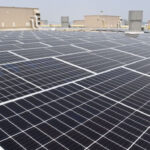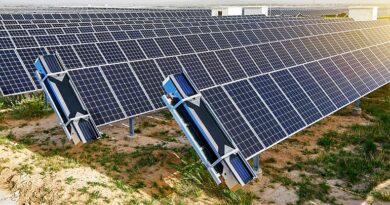REC Solar installs specialized project at observatory atop dormant volcano in Hawaii
REC Solar, a business unit of Duke Energy, has completed the world’s largest commercial solar system at the highest altitude of 13,600 ft atop the W. M. Keck Observatory in Hawaii.
 The 133-kW solar project – located near the summit of Mauna Kea, a dormant volcano on the Big Island of Hawaii – is located on the rooftop of Keck Observatory’s telescope facility, between the domes of the twin Keck I and Keck II – among the world’s largest optical and infrared telescopes. The system will annually produce 259.1 MWh of energy, which will reduce the observatory’s electric power needs by about 15%.
The 133-kW solar project – located near the summit of Mauna Kea, a dormant volcano on the Big Island of Hawaii – is located on the rooftop of Keck Observatory’s telescope facility, between the domes of the twin Keck I and Keck II – among the world’s largest optical and infrared telescopes. The system will annually produce 259.1 MWh of energy, which will reduce the observatory’s electric power needs by about 15%.
“Incorporating renewable energy generators such as solar PV is important to Keck’s core values of stewardship and service. It will reduce our reliance on electricity derived mainly from fossil fuels, which underscores our efforts to be good stewards of the planet,” says project lead Mark Devenot, infrastructure specialist at Keck Observatory.
 Hawaiian Electric approved operation of the PV system on Sept. 30, 2020. The system consists of 332 solar panels that are strategically placed on the unique 20,940-sq.-ft ballasted roof to avoid snow and ice fall from the domes, as well as high winds that occasionally occur a few times a year.
Hawaiian Electric approved operation of the PV system on Sept. 30, 2020. The system consists of 332 solar panels that are strategically placed on the unique 20,940-sq.-ft ballasted roof to avoid snow and ice fall from the domes, as well as high winds that occasionally occur a few times a year.
“One of the biggest challenges was attaching the PV array to this type of roof, which has no structural framework to anchor the system,” says Devenot.
To address this issue, the solar system was custom engineered for the unique ballasted roof design and to support high winds. The team also had to deal with working at high altitude, which averaged 40% less oxygen than at sea level.
“Incorporating rooftop solar at Keck Observatory has been a special experience for the REC Solar team due to the project’s focus on science, safety and innovation,” says Dan Alcombright, managing director, growth implementation at Duke Energy. “Our team remained respectful of land and wind limitations throughout construction and leveraged our local experience and detailed weather data to engineer solar with specialized mechanical attachments that can handle the wind gusts and climate of a Pacific island at high altitude. We’re pleased to be able to provide Keck with a viable energy solution that positively impacts both their organization and the environment.”
 At high altitude, the panels will catch more photons and produce more energy than at sea-level locations. This is because sunlight atop Mauna Kea doesn’t have to travel through as much of the Earth’s atmosphere where the photons could be absorbed by something else. Having 40% less atmosphere, which is one of the reasons that makes Mauna Kea one of the best places on Earth to conduct astronomy, also makes for efficient solar energy generation.
At high altitude, the panels will catch more photons and produce more energy than at sea-level locations. This is because sunlight atop Mauna Kea doesn’t have to travel through as much of the Earth’s atmosphere where the photons could be absorbed by something else. Having 40% less atmosphere, which is one of the reasons that makes Mauna Kea one of the best places on Earth to conduct astronomy, also makes for efficient solar energy generation.
This new rooftop solar installation at Keck Observatory’s telescope facility on Mauna Kea provides a unique research opportunity for the team to gather data on how solar panels operate in a thinner atmosphere with a high UV index and under higher than average winds. The REC Solar team will continue to monitor and analyze these conditions for future solar installations at high altitudes.
News item from REC Solar
<!–
–>
Original Source: https://www.solarpowerworldonline.com/2020/12/rec-solar-installs-specialized-project-at-observatory-atop-dormant-volcano-in-hawaii/












